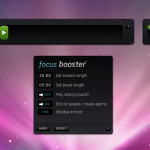 The tried-and-true method we organizers use goes like this:
The tried-and-true method we organizers use goes like this:
- Take everything out and sort by putting like things together
- Let go of stuff you don’t use or find beautiful, and move things you don’t use in this room to where they are used.
- Find homes for what is left.
Let’s stop at step three and camp there today. People ask me, “Martha, how do I decide where to put things? What dictates the home I choose?”
My answer is, “Think of the space you are organizing as a bull’s-eye with you at the center.”
Stand or sit where you will perform one of your main tasks. Then ask yourself these questions:
- What supplies or tools do you use everyday?
Place those items within the first circle radiating outward on your bull’s-eye, within arm’s reach. Counters and desk tops are prime real estate. Only allow daily use items to live there. Convenient drawers can be used to corral small things.
Kitchen – on counter: coffeemaker, knife holder, paper towels
Office – on desk: writing tools, stapler, computer, and phone, current project files
Bathroom – on counter: favorite makeup, razor, liquid soap dispenser, 5 oz cup holder
Bedroom – on bedside table: lamp, book you are currently reading, alarm clock
- What supplies or tools do you use on a weekly basis?
Go one circle further out on your bull’s-eye. These things should be within a step, or one level up/down from work surface, preferably in a closed cabinet or drawer. Think of your waist as best height, so choose between knees and shoulders for this ring.
Kitchen – baking pans, lesser-used utensils (those long ones with odd shapes!), plastic storage containers, towels and dish clothes.
Office desk – frequently referenced files, extra staples, whiteout, 3 hole punch, copy paper supply
Bathroom – pain medicine, extra toilet paper, replacements of toothpaste and shampoo
Bedroom – everyday wardrobe, robe, cough drops, flashlight, set of linens, extra blanket, pair of reading glasses
- What supplies or tools do you use say… once a month or every other month?
Yep, one more ring out from the center of your bull’s-eye. Place these files, supplies, tools across the room or even in an adjacent room. You still want fairly easy access – no ladder or going through piles of boxes.
Kitchen – the crock pot or rice cooker, pantry supplies, and serving dishes for company
Office desk – reference (finished) files, book case, mailing supplies
Bathroom – linens, first aid supplies, heating pad
Bedroom – extra pillows and blankets for company, reference books, boots, seasonal clothing not being used
- What are the things you use consistently, but only on a seasonal basis – once a year or less?
These are best assigned the highest shelf, or placement in the basement, garage or attic.
Kitchen – Christmas cookie cutters, punch bowl, Easter baskets, large coffee urn
Office – folding table, tax records 2-7 years old
Bathroom – nothing, if you haven’t used it in a year, toss it!
Bedroom – family heirloom quilts maybe? Otherwise, ditto from above.
The things you love or find beautiful can find homes on the wall, displayed on a shelf, or in an archival box to be displayed on a rotating basis with your other treasures.
If you don’t love it or use it, why would you keep it around? Give the good things to someone who can use or appreciate them and toss the rest.
Now you have a home for everything. Make your stuff go home every night. Don’t let those guys go on permanent vacation!







 I had a wonderful time recently with 6 gals and 1 guy in my photo organizing workshop at Westerville Senior Center. It seemed fitting as we sorted memories that we met at the
I had a wonderful time recently with 6 gals and 1 guy in my photo organizing workshop at Westerville Senior Center. It seemed fitting as we sorted memories that we met at the 
